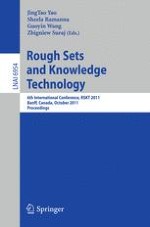2011 | Buch
Rough Sets and Knowledge Technology
6th International Conference, RSKT 2011, Banff, Canada, October 9-12, 2011. Proceedings
herausgegeben von: JingTao Yao, Sheela Ramanna, Guoyin Wang, Zbigniew Suraj
Verlag: Springer Berlin Heidelberg
Buchreihe : Lecture Notes in Computer Science
